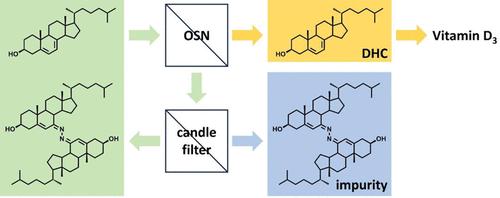当前位置:
X-MOL 学术
›
Org. Process Res. Dev.
›
论文详情
Our official English website, www.x-mol.net, welcomes your
feedback! (Note: you will need to create a separate account there.)
Industrial-Scale Organic Solvent Nanofiltration for Dimer Impurity Removal: Enhancing Vitamin D3 Production
Organic Process Research & Development ( IF 3.1 ) Pub Date : 2024-10-25 , DOI: 10.1021/acs.oprd.4c00333 Jan Schütz, Julia Witte, Maurus Marty, Roman Goy
Organic Process Research & Development ( IF 3.1 ) Pub Date : 2024-10-25 , DOI: 10.1021/acs.oprd.4c00333 Jan Schütz, Julia Witte, Maurus Marty, Roman Goy

|
This work details the removal of an azine-dimer (AD) impurity from 7-dehydrocholesterol (DHC), a precursor of vitamin D3, using a newly developed, sustainable hybrid membrane process, from the idea to implementation. Developed by an international team collaborating under tight time frame and COVID restrictions, this innovative method exemplifies a versatile, energy-saving, and cost-effective separation technology by organic solvent nanofiltration (OSN). Traditional purification methods proved to be unsuccessful, costly, or unsustainable, but this process achieved DHC purification with a minimal yield loss of 0.1%. This separation challenge goes beyond typical OSN applications (solute concentration or solvent exchange) by separating two similar solutes in a solvent mixture. In a three-stage OSN process, the impurity level was reduced from approximately 2600 ppm to below 50 ppm in the final permeate. After developing and scaling up the process, the OSN, precipitation, and filtration units were engineered and constructed. These units were installed in the dsm-firmenich vitamin D3 plant, and the purification process was successfully commissioned.
中文翻译:

用于去除二聚体杂质的工业规模有机溶剂纳滤:促进维生素 D3 的产生
这项工作详细介绍了使用新开发的可持续杂化膜工艺从维生素 D3 的前体 7-脱氢胆固醇 (DHC) 中去除嗪二聚体 (AD) 杂质,从构思到实施。这种创新方法由一个国际团队在紧迫的时间框架和 COVID 限制下合作开发,体现了一种多功能、节能且具有成本效益的有机溶剂纳滤 (OSN) 分离技术。传统的纯化方法被证明是不成功、昂贵或不可持续的,但该工艺以 0.1% 的最小产量损失实现了 DHC 纯化。这种分离挑战超越了典型的 OSN 应用(溶质浓缩或溶剂交换),即在溶剂混合物中分离两种相似的溶质。在三级 OSN 工艺中,最终渗透液中的杂质水平从大约 2600 ppm 降低到 50 ppm 以下。在开发和扩大工艺规模后,设计和建造了 OSN、沉淀和过滤装置。这些装置安装在帝斯曼-芬美意维生素 D3 工厂中,并成功调试了纯化过程。
更新日期:2024-10-25
中文翻译:

用于去除二聚体杂质的工业规模有机溶剂纳滤:促进维生素 D3 的产生
这项工作详细介绍了使用新开发的可持续杂化膜工艺从维生素 D3 的前体 7-脱氢胆固醇 (DHC) 中去除嗪二聚体 (AD) 杂质,从构思到实施。这种创新方法由一个国际团队在紧迫的时间框架和 COVID 限制下合作开发,体现了一种多功能、节能且具有成本效益的有机溶剂纳滤 (OSN) 分离技术。传统的纯化方法被证明是不成功、昂贵或不可持续的,但该工艺以 0.1% 的最小产量损失实现了 DHC 纯化。这种分离挑战超越了典型的 OSN 应用(溶质浓缩或溶剂交换),即在溶剂混合物中分离两种相似的溶质。在三级 OSN 工艺中,最终渗透液中的杂质水平从大约 2600 ppm 降低到 50 ppm 以下。在开发和扩大工艺规模后,设计和建造了 OSN、沉淀和过滤装置。这些装置安装在帝斯曼-芬美意维生素 D3 工厂中,并成功调试了纯化过程。






























 京公网安备 11010802027423号
京公网安备 11010802027423号